One of the best ways to achieve a fully organic garden with a great impact on the environment is by regularly feeding it with fresh compost. And while you can buy it bags at any garden center, creating your own home compost pile is a much more eco-friendly solution.
Not only will you be able to deal with all those grass clippings and pruned shrubs and flowers, but you can also add food scraps so they don’t end up causing greenhouse gas emissions at a landfill.
Now, you might think that having managed a compost bin, you can take the exact same approach with compost piles. But there are some subtle differences to consider.
Let’s take a closer look.
Compost Pile vs. Compost Bin: Are You Choosing The Right Path?
Here are the main things to consider before you decide on the best option for you.
What Is An Open Air Compost Pile?
An open compost pile is any organic materials that you collect in your home and garden and collect in one place. It’s typically not contained in a box or even sectioned off with some solid borders but rather just loosely piled up.
It’s particularly convenient if you end up with a lot of grass clippings from a large lawn and lots of other green materials from pruning in your garden. Those can quickly compost bins, making it difficult to keep up with this process.
It’s also easier to mix in carbon-rich materials in such a large pile from time to time.
How Is It Different From a Compost Bin?
A compost bin, on the other hand, is a self-contained device that you can fill and seal off from the environment. It’s great for handling organic waste from your kitchen, like vegetable scraps. This option is best for apartment composting.
The reason people like using such bins is that they help to contain any smells and odors, and it’s a lot easier to regularly rotate the bin to speed up the composting process. They also go hand-in-hand with container gardening.
One issue you will find is that you might need more than one of these if you quickly fill it up with food waste and green materials from gardening.
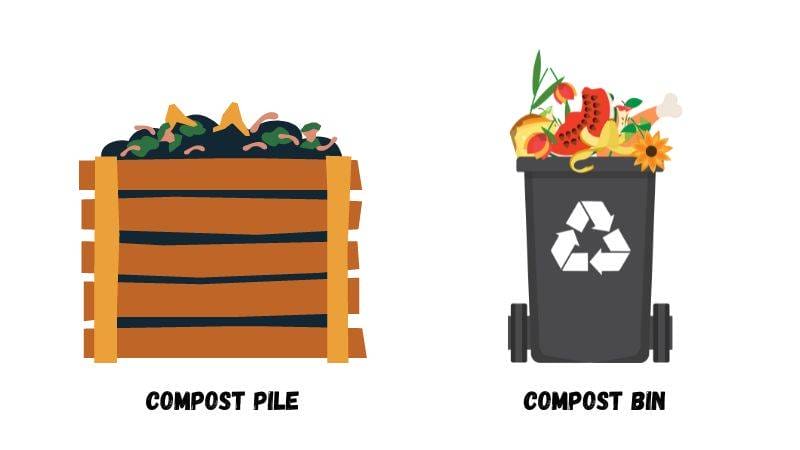
Which Option Is Better For You?
If you have a small garden or yard, and you don’t want to have smells lingering when you enjoy some outdoor recreation time, then a bin will be great for handling the composting process.
It’s also a lot more convenient to regularly top up with food scraps and brown materials to achieve the right mix and get a very fertile finished compost.
However, if you have a large garden and you can section off an area for an open pile to handle a lot of green stuff and food scraps, then a compost pile will be easier to handle. You will need to invest a bit more time and effort into rotating it regularly, but it’s a great way to produce a lot of compost.
How Composting Works
When it comes to open bin composting or simply piling garden and food waste, there are some clever natural mechanisms that you take advantage of.
The 3 Stages of Composting
In order to understand how composting works, it’s easiest to look at the three stages of composting that this process goes through.
Stage 1: Mesophilic Phase
The first thing that happens is that a group of bacteria called mesophilic organisms will get to work on the organic and carbon-rich materials in a pile. These tend to thrive at temperatures from 85 to 110 Fahrenheit.
They start to break down the materials into smaller pieces and crucially increase the temperature inside the pile so that other organisms can join the process.
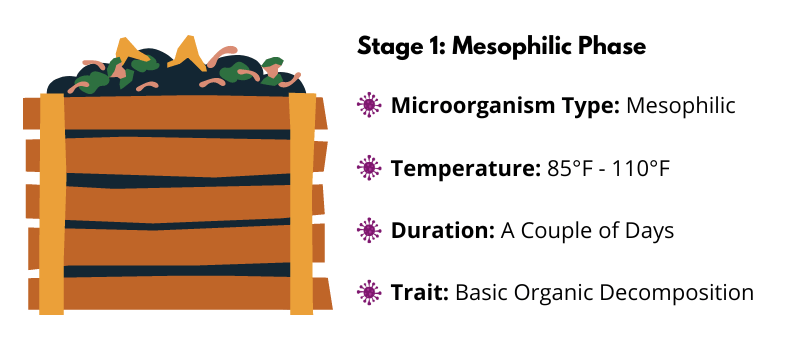
Stage 2: Thermophilic Phase
This is where thermophilic microorganisms come into play, but they require a temperature range from about 110 to 250 Fahrenheit.
Yes, it can get pretty hot inside a compost pile, but that’s a good sign that it’s working the way it should. What these organisms do is get to work on proteins, fats, and complex carbs that you’ll have in garden waste and vegetable scraps.
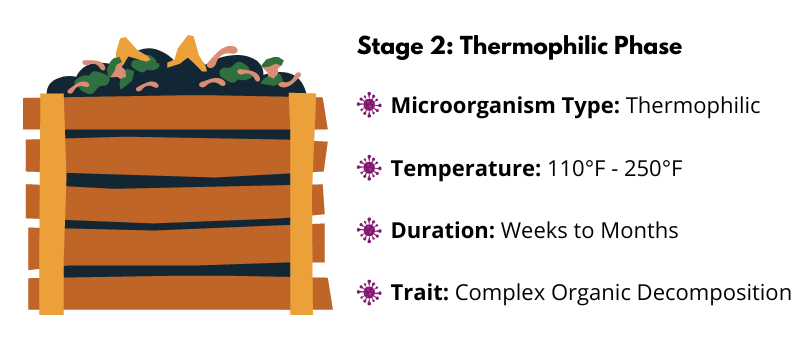
Stage 3: Maturation Phase
As stage 2 approaches its final phases, the temperatures will start to drop again, and this allows the mesophilic organisms to join in again and break down the remaining materials into the finished compost.
You can also boost the composting process with some compost starters.
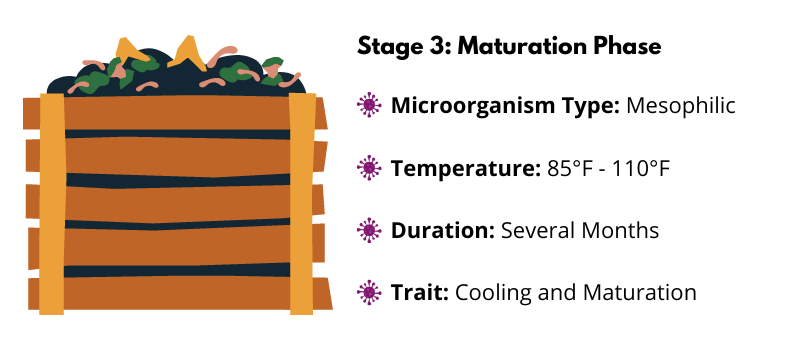
Green and Brown Materials
Your compost pile will rely on two forms of nutrition which are nitrogen and carbon. These are also respectively called green and brown materials, and it’s important that you provide both of these in adequate quantities.
Ideally, you want to achieve a 1-to-2 ratio between brown and green materials, and here is what to keep in mind.
Green materials include food scraps, coffee grounds, tea bags, grass, and plant clippings, and brown material includes newspapers, cardboard, sawdust, and dried leaves. It’s best to shred or at least tear these down into small pieces so that they break down faster during composting.
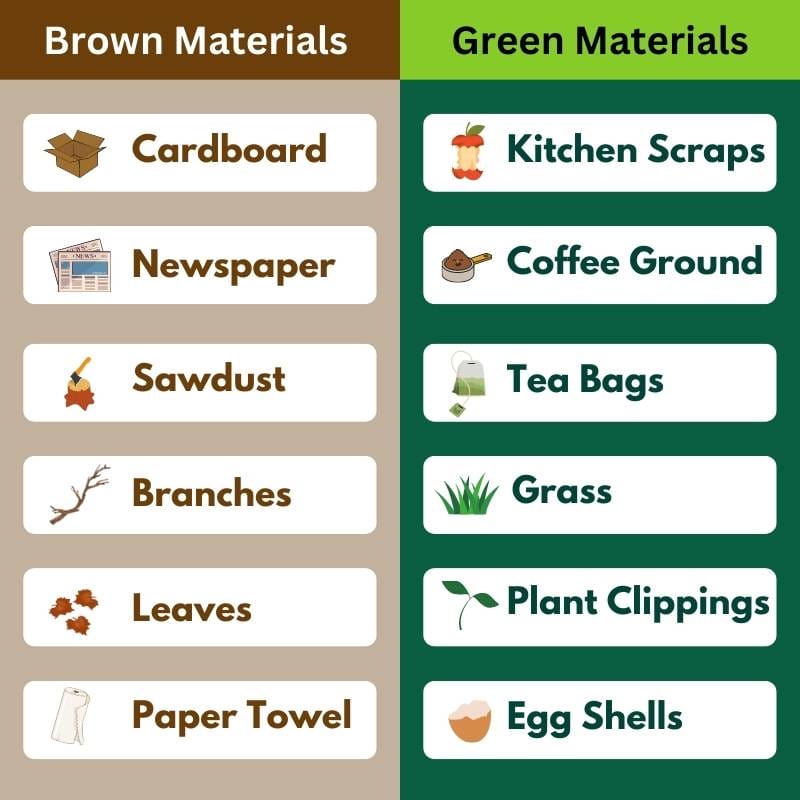
The Secret To A Healthy Compost Pile: Carbon/Nitrogen Ratio
I hinted at the ideal ratio of carbon and nitrogen above, and it’s worth highlighting it here as a critical factor in composting. One of the most common reasons that a compost pile fails is that there is way too much nitrogen or carbon.
What you want to achieve is having 1/3 of the pile made up of green material that is nitrogen-rich and 2/3 made up of brown material that is carbon-rich. That’s why it’s so important to gather up all those branches and dried leaves in the garden and put them to good use.
Build A Compost Pile In 7 Simple Steps
Getting started with a compost pile in garden and yard spaces is a lot easier than you might think. And with a little bit of careful planning, you’ll increase your success rate a lot.
1 – Choose The Right Outdoor Space
The first thing I would suggest is that you pick a space that isn’t directly up against a building, and it also shouldn’t be too sheltered.
I pick a corner of my garden that gets some afternoon sunlight and is far enough away from my patio seating area not to become a smelly distraction. The sun ensures that it never gets too cold for the bacteria to do the work. I also ensure that rain can fall directly on it to save me from watering it more than I have to.
2 – Build A Base Layer
You want to create a base layer first with small branches, twigs, and straw. I generally build this up to about two or three inches high.
This helps to provide a drainage layer so that water can trickle down and not build up in pools. While water is important, you don’t want the pile to become saturated either, as that can slow down and stall the composting process.
I’ve also heard of people using an old transport pallet with some straw, which can work just as well.
3 – Layer Nitrogen And Carbon Rich Material
This is now where you need to plan out how you layer your compost materials. What I recommend that you do is layer these about one to two inches thick.
Here’s what I mean.
Start with a high-nitrogen materials layer by adding food scraps, grass, and coffee grounds. Build this up to about one inch thick, and then start adding carbon-rich brown materials.
This is where it can be helpful to have old newspapers and cardboard boxes that you shred and tear up. And you can also use dried leaves and pine needles that you may have raked up last fall.
Add this as a two-inch layer and then gradually repeat the process.
4 – Spray The Layers With Water
Water is also an important factor when it comes to speeding up the compost process in an outdoor space. What I do is use a watering can and spray about half a gallon of water on every second or third layer.
How much water you use will depend on the size of the pile, just don’t saturate the materials.
A lot of the water will evaporate as the heat increases, and the moisture helps to ensure that bacteria can survive and thrive in the environment.
5 – Add Compost Worms
If you’ve ever used a compost bin, then you’ll be familiar with the process of adding compost worms. These are great helpers in breaking down larger materials like food scraps and leaves faster.
When you have an open pile of compost, then worms will naturally be attracted to it from the ground. But you can speed up that process by heading to your local garden center and buying a small bag of compost worms.

Read More:
6 – Regularly Turn The Pile
The compost bin I have in my garden is great because I can easily rotate it. But with an open compost, you have to regularly turn the materials on the pile.
What I mean by regularly is about every two weeks. You don’t want to do this too often, as turning the pile will impact the temperature at the center, which could have a negative impact.
What this process does is aerate the compost to allow more oxygen to flow through the layers so that the bacteria can thrive better.
7- Keep Spraying It With Water
The other thing you need to keep in mind is that you can’t allow your compost to get too dry. The heat inside will cause water to evaporate, and if it gets too dry, then you’ll significantly slow down the process.
If you live in a dry climate, that will mean spraying a few gallons of water each week. But factor in any rainfall you have, and if you place your compost in an ideal location, then you probably won’t have to water it too often.
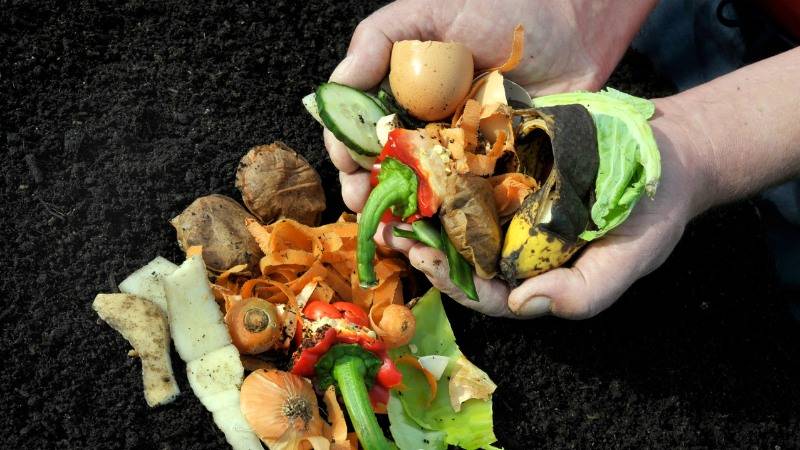
What You Can And Cannot Put In A Composting Pile
Now, let’s take a closer look at what kind of composting materials you should gather and which ones to avoid.
Green Nitrogen Material
You’ll probably find it very easy to find enough nitrogen-rich materials around your garden and home to add to your compost regularly.
Grass Clippings And Other Garden Waste
Here is a list of some nitrogen-rich materials that you can add to feed the decomposition process:
- Grass
- Plant clippings
- Weeds
- Fresh leaves
One thing I would highlight here is that you want to be careful with green yard waste if you tend to use chemical fertilizers. Many people like to create their own compost to make it organic.
And that fertilizer can become concentrated in your compost as it won’t break down. Just keep that in mind if you have an organic vegetable patch.
Kitchen Waste
I would suggest buying a small compost material collection bin for your kitchen. You can buy these with a carbon filter so that there are no smells, and it saves you a trip to the compost every time you have some kitchen scraps.
Here are some things to start collecting:
- Uncooked vegetable scraps
- Moldy fruit
- Stale bread
- Coffee grounds
- Non-plastic tea bags
- Eggshells
Brown Carbon Material
The carbon-rich usable compost material is just as important, and this is where you can start collecting old newspapers and paper towels. Just make sure they aren’t contaminated with animal products.
Here’s what you can start gathering up.
- Saw dust
- Newspapers
- Paper towels
- Tissues
- Dry leaves
- Straw
- Hay
Materials To Avoid
Just as important as getting the right materials for nutrient-rich soil, it’s vital that you pay attention to what you can’t add to compost.
Here are some of the most important ones to avoid:
- Plastics
- Styrofoam
- Vegetable oil
- Meat
- Fish
- Bones
- Dairy products
- Cooked food
- Diseased plants
Basically, if you’re in doubt, it’s best not to add it to your outdoor compost pile.
How To Maintain Your Compost Piles
If you’re like me, then you’ll probably become a bit impatient with your first open compost attempt. The good news is that even if it takes longer, you’ll eventually have a large pile of highly fertile compost for your garden beds and greenhouse.
Once you start composting, here are some personal tips I would give you.
Use An Activator
If you ask at your local garden center, they’ll likely have a compost activator. This is typically used for composting indoors and in bins, but if you want to really kick start your outdoor pile, then sprinkling some of this in will work wonders.
These contain partially rotted leaves, grass, and even chicken manure to introduce live bacteria.
Avoid Odors
If you live in an urban area or your garden isn’t that large, then having an open pile can leave some odors that build up on a calm and sunny day. A simple trick is to always have some grass available to cover the fresh kitchen waste you’re adding. Or, you can always opt for using some natural odor removers.
Also, make sure that nobody is adding meat and bones in error, as these will start to smell very badly.
Repel Flying Insects
It shouldn’t come as a surprise that insects will be attracted to the food. Fruit flies are the most common, but you can significantly limit those. Either make sure that you add grass on top of any fruit and vegetables.
Or, if you don’t have some grass handy, use a pitchfork to lift up a few inches at the top of the pile and put new food materials underneath.
Frequently Asked Questions (FAQ)
The best time of year to start composting is in the fall, as this is typically when you’ll have the most amount of green stuff to get started. But I have started a fresh pile pretty much any time of the year.
It will only take you half an hour to start a compost pile if you have garden waste available. Once you get started, it will take about five months for all the materials to fully break down and be ready as fresh garden soil.
Three key ingredients to a good compost head are nitrogen, carbon, and water. That means adding kitchen scraps, coffee grounds, paper, and plant clippings. You also need to keep the pile moist for a better environment for bacteria.
Yes, you can compost directly into soil. I often do this with vegetable plants in my greenhouse that have reached the end of the season. I simply cut them up and mix in some newspaper and then bury them in the soil.
Yes, it’s absolutely OK to plant directly into compost. You can do this for flowers, plants, and vegetable plants, as the fresh compost will provide a maximum amount of nutrients to help speed up the initial growth.
You should ideally keep your compost in the sun. This will help to keep the temperature higher so that certain organisms thrive. Just make sure that the sun doesn’t dry out the pile too much.
Compost should never be dry, as this will not allow organisms to grow and multiply. Keeping your compost moist at all times will provide a much better breeding ground. Just avoid excess moisture building up into pools of water by having a good base layer.
Conclusion
Now that you understand how to start a compost pile in your backyard, it’s simply time to take those first steps to create the base layer. Once you have that in place, simply start collecting coffee grounds and kitchen scraps and layer in all the stuff you collect up in the garden.
It’s a very satisfying process and one that will pay off a huge amount once you see the results of a truly organic flower bed or vegetable patch.
You’ll also find that your homemade compost will be a lot more fertile than anything you buy in stores and that your plants, fruit, and vegetables will thrive in these conditions.


